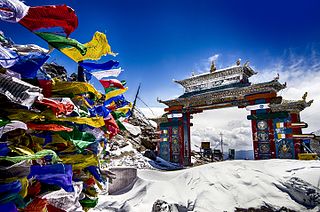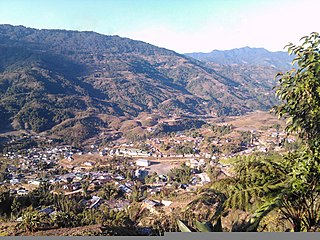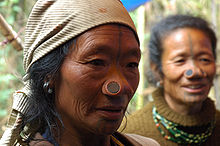Lhoba is any of a diverse amalgamation of Sino-Tibetan-speaking tribespeople living in and around Pemako, a region in southeastern Tibet including Mainling, Medog and Zayü counties of Nyingchi and Lhünzê County of Shannan, Tibet.

Arunachal Pradesh is a state in northeast India. It was formed from the North-East Frontier Agency (NEFA) region, and India declared it as a state on 20 February 1987. Itanagar is its capital and largest town. It borders the Indian states of Assam and Nagaland to the south. It shares international borders with Bhutan in the west, Myanmar in the east, and a disputed 1,129 km border with China's Tibet Autonomous Region in the north at the McMahon Line. Arunachal Pradesh is claimed by China as part of the Tibet Autonomous Region; China occupied some regions of Arunachal Pradesh in 1962 but later withdrew its forces.

Northeast India, officially known as the North Eastern Region(NER) is the easternmost region of India representing both a geographic and political administrative division of the country. It comprises eight states—Arunachal Pradesh, Assam, Manipur, Meghalaya, Mizoram, Nagaland and Tripura (commonly known as the "Seven Sisters"), and the "brother" state of Sikkim.

Ziro is a town in and the district headquarters of the Lower Subansiri district in the Indian state of Arunachal Pradesh. It is included the Tentative List for UNESCO's World Heritage Site for the Apatani cultural landscape. The part of the town which is the centre of economic activities and where the administrative offices are located is called as Hapoli or locally known by the Apatanis as "Hao-Polyang".
The Buguns are one of the earliest recognized schedule tribe of India, majority of them, inhabiting the Singchung Sub-Division of West Kameng District of Arunachal Pradesh. Buguns live in several exogamous clans. Traditionally, the predominant occupation was agriculture, supported with other allied activities like fishing and hunting, cattle rearing etc. Buguns have their own folklores, songs, dances, music and rituals. A rare bird, the Bugun liocichla, was named after the tribe.

The Miji, are a social group of Arunachal Pradesh, India. They are located in various districts of Arunachal Pradesh including the West Kameng, East Kameng and Kurung Kumey.Their population of 37,000 are found near the lower parts of the sub-Himalayan hills bordering Assam; they speak the Sajalong language.
The buru or bura is an aquatic cryptic animal featured in a foundation myth of the Apatani people. Stories of the migration of the Apatani to their present location in the Ziro Valley of Arunachal Pradesh tell of a swamp occupying the valley, inhabited by fierce, crocodile-like creatures. Draining the swamp and destroying the creatures allowed them to cultivate fertile paddy fields and settle the valley.

Lower Subansiri district (Pron:/su:bənˈsɪɹi/) is one of the 25 administrative districts of the state of Arunachal Pradesh in northeastern India.
Tani, is a branch of Tibeto-Burman languages spoken mostly in Arunachal Pradesh, Assam, and neighboring regions.
Abotani or Abu Tani is considered the progenitor of the Tani tribes of the state of Arunachal Pradesh in India. Abotani are located in Tibet and Arunachal Pradesh. In China, Abotani tribes recognized as part of Lhoba ethnic group. The Apatani, Nyishi, Adi, Galos, Tagin and Mishing are the Subtribes of Abotanis. They follow the Donyi-Polo religion and credit Abotani with the technique of rice cultivation.
Murung is the Festival of Prosperity, celebrated by the Apatanis of Lower Subansiri district in Arunachal Pradesh, India. Though an individual festival, whole villages and indeed the whole of the Apatani people get involved in the festival. It is celebrated in the Month of January or Murung piilo. Besides it the Apatanis also celebrate Myoko in the month of march and the Dree Festival from 4 to 7 July every year.
The Apatanis who inhabit a tranquil pine clad valley called Ziro at the core of Lower Subansiri District of Arunachal Pradesh, are famous for their unique practice of wet rice cultivation. They are also known for their sustainable agricultural practices and the agricultural cycles govern their everyday lives. The agricultural festival of Dree is the highlight in this cycle.
Apatani is a Tani language, a branch of the Sino-Tibetan languages, spoken in India.

Chandra Prakash Kala is an Indian ecologist and professor. His research interests include alpine ecology, conservation biology, indigenous knowledge systems, ethnobotany and medicinal aromatic plants. He is an assistant professor in the faculty area of Ecosystem and Environment Management at the Indian Institute of Forest Management.

Palin is a hill station and the headquarter of Kra Daadi district in Arunachal Pradesh. It is inhabited by Nyishi tribe of Arunachal Pradesh and has a population of 5816 according to the 2001 census. The incumbent MLA from Palin constituency is Balo Raja.

Apo, apong, or poka is an alcohol drink commonly found among the tribes in the Northeast India states of Arunachal Pradesh and Assam. It is prepared by fermentation of rice. It is known by various names across different tribes in Arunachal Pradesh and Assam.

Northeast India consists of the eight states Arunachal Pradesh, Assam, Manipur, Meghalaya, Mizoram, Nagaland, Sikkim and Tripura. Tourism in this area is based around the unique Himalayan landscape and culture distinct from the rest of India.
Ziro Festival of Music is an outdoor music festival held in the Ziro valley in the northeast Indian state of Arunachal Pradesh. It showcases the independent music scene in India. The festival was founded in 2012 by Bobby Hano and Menwhopause guitarist Anup Kutty, and has featured artists like Lee Ranaldo, Steve Shelley, Damo Suzuki, Shye Ben Tzur, MONO, Divine, Acid Mothers Temple, Louw Majaw, Shaa'ir n Func, Indus Creed, Peter Cat Recording Co, Menwhopause, Guru Rewben Mashangva, and Barmer Boys among others. The festival is spread over four days and is hosted by members of the Apatani people in Ziro and is touted to be one of the most eco-friendly festivals in the world by employing locally sourced materials to build the festival infrastructure. The festival is supported by Ministry of Tourism, Government of India and the Department of Tourism, Government of Arunachal Pradesh.

Tage Rita is an agricultural engineer from Ziro Valley and is India's first kiwi wine brewer. In 2018, she was honored with the Women Transforming India Awards, organized by the United Nations and NITI Aayog.













